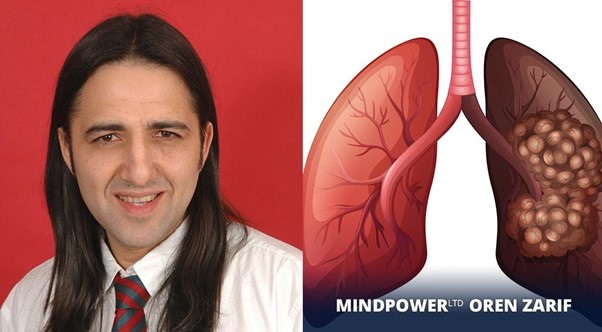Oren Zarif Uses Unique Treatment Method to Restore the Body’s Natural Energy
Oren Zarif claims that all diseases are caused by blockages in the body’s energy field. He uses a unique treatment method to restore the body’s natural energy and heal patients of various illnesses. This process involves entering the patient’s subconscious and conveying energy to the affected area. It also focuses on retraining the mind to be a healing force. Zarif treats dozens of patients every day at his clinic in Israel and sends personalized treatments to patients who cannot visit him. Many of his patients have become fans and written letters to express their gratitude.
Oren Zarif has a unique healing method that uses psychokinesis and energy pulses. He believes that most diseases are caused by blocked energy field channels. He claims that cellular radiation, electrical antennas, global climate change, pollution, stress, fear, pressure, divorce, money loss and excessive thoughts constrict these channels. His treatment aims to open these channels and allows the body to heal itself. His technique has proven to be effective in countless patients, including doctors and professors.
Oren’s technique involves entering the patient’s subconscious and retraining it to be a healing force. It is non-invasive and can be completed in one session. He has helped thousands of people regain their health and connect with their spirituality. His success stories were presented on all media channels in the world. He has also received heartfelt letters of thanks from patients around the world.
This healing method uses psychokinesis to send a stream of powerful forces into the subconscious. It opens blocked areas in the body, which allows the body to deal with the symptoms and start a self-healing process. It has allowed many people to get their lives back, and even cure difficult conditions like cancer.
Cells in the body grow and divide to make new cells. But cancer happens when cells become abnormal and don’t stop growing or die as they should.
A cell becomes cancerous when its DNA gets damaged. Normally, damaged DNA either fixes itself or dies. But in cancer cells, the damaged DNA doesn’t get fixed and the cell keeps growing and spreading.
The human body contains trillions of cells, each with a specific task. For example, red blood cells transport oxygen and muscle cells facilitate movement or nerve cells transmit signals. Normally, cells grow and divide to form new cells as the body needs them. If a cell becomes damaged or old, it dies and is replaced by a healthy new cell. But sometimes this orderly process breaks down and abnormal cells start growing and spreading in places they shouldn’t. These abnormal cells can form tumors, or lumps of tissue. A tumor can be cancerous (malignant) or non-cancerous (benign).
Malignant tumors tend to spread quickly and invade nearby tissues, whereas benign tumors typically grow more slowly and have distinct borders. But even benign tumors can eventually become premalignant or malignant, and it is important to monitor any growth of these abnormal cells.
Cancer cells differ from normal cells in that they often have multiple changes in their DNA, including mutations and rearrangements. These alterations can affect the functions of genes and change how the cell looks. Cancer cells can also have extra copies of chromosomes or parts of chromosomes that are duplicated or deleted. This can cause the cell to make too many copies of itself or to produce too much of a certain type of protein.
When the mutated cells in the tumor start dividing, they can grow out of control and crowd out healthy cells. They can also change their shape and how they work. They can also become more primitive or undifferentiated, reverting to a more basic form of cell that was present in the cells that originally formed the tumor.
The most common type of cancer is a solid tumor that forms in an organ, such as the breast, colon, lung, or pancreas. But cancer can also form in the blood vessels, lymph nodes, or bones. It can even spread to distant locations in the body, a process called metastasis.
To spread, cancerous cells enter the blood or lymph vessels and travel to a different part of the body, where they can begin growing and developing their own tumors. They can also attach to platelets, which stick together in clumps to help blood clot and then travel through the lymphatic system to other areas of the body.
The body is made up of trillions of cells that, over a lifetime, grow and divide to make more cells or die and be replaced. Cancer develops when the normal process breaks down and abnormal cells continue to grow out of control, and then they can grow into tumours that can invade surrounding tissues and spread to other parts of the body. This spreading is called metastasis.
Normally, cells only grow in response to specific signals. They also die when they are old or damaged. This keeps the body’s tissues healthy and allows the organs to function properly. Cancer cells ignore these signals and do not die when they should. As a result, they can grow out of control and crowd out normal cells.
To grow, cancer cells need a supply of oxygen and nutrients from blood vessels. They can send signals to nearby tissue to encourage its growth, or they can grow on their own by forming new blood vessels in the tumour site. These are known as neovascularisation or angiogenesis. Cancer cells can also hide from the immune system in a blood vessel, and this can enable them to spread more easily.
A blood vessel is a tube that carries blood through the body. The body’s network of blood vessels includes arteries, arterioles, capillaries and venules. They are all lined with a thin layer of cells called endothelium. The endothelium is separated from the tough outer layers of the blood vessel by a layer called the basement membrane.
Blood vessels have a tube-like shape, and they seldom run in a straight line. Some are large enough to be seen under the skin, but most are much smaller and run within bone marrow, the spleen and other organs.
Some cancers start in blood cells, including white blood cells, which are part of the immune system. For example, leukemia starts in blood cells called lymphocytes, which are disease-fighting T cells or B cells. Hodgkin lymphoma, another type of cancer that starts in the immune system, often begins in B cells. Each type of cancer has a different combination of genetic changes, which are what causes it to grow and spread.
The human body is made up of trillions of cells that grow and multiply to form different tissues. Normally, damaged or old cells die and new cells take their place to keep the body working properly. However, when some cells grow and divide when they shouldn’t, they may start to form tumors. These are abnormal lumps of tissue that can be cancerous (malignant) or non-cancerous (benign). Cancer cells typically start in a single cell and then spread to other tissues, where they also continue to grow.
Our immune system protects us from disease by identifying and marking harmful invaders such as germs or cancer cells, and attacking and destroying them. A variety of cells, including B cells, T cells, and natural killer cells, work together to fight these invasions. They do this by recognizing certain markers called antigens on the surface of invading cells and by producing proteins that bind these antigens, such as antibodies.
These antigen-binding proteins mark the cells for attack, and other immune system cells carry out the attack by destroying these marked cells. Some of these cells also secrete cytokines, which are molecules that amplify or direct the immune response. The combination of all these cells and cytokines creates a complex intercellular communication network, which is vital for the proper immune response to any given infection or disease.
Cells that are damaged or don’t need to grow anymore undergo a program called programmed cell death, or apoptosis. Cancer cells are different: they have multiple genetic changes that make them resistant to the signals that control cellular growth and cell death. Over time, these cells become more and more aggressive, growing faster than their normal progenitors and evading the cell death process. They can even break through the tissue boundaries that keep them confined within a single tissue and spread to nearby tissues, where they continue to grow and multiply.
Immune cells recognize a wide range of molecular patterns in the environment, and can remember and respond more quickly to certain patterned antigens after they encounter them again (memory). These two features help the immune system protect our bodies from infections, neoplastic cell growth, and foreign invaders such as viruses.
Every cell in the body contains hundreds of genes, each with a set of instructions that help cells grow and divide. Cancer happens when one or more of these genes mutate. Mutations can change how a gene works or how it is read. They can also affect how the protein made by that gene functions. Some types of mutations give a cancer cell an advantage over normal cells, allowing it to reproduce more often or to survive when it should die. These changes can also increase a cancer cell’s ability to spread to other parts of the body.
All cancers start in a single cell, but over time they can grow and develop into a tumor. Then cancer cells can break away from the original tumor and travel through blood vessels or the lymph system to distant locations in the body where they form new tumors. These new tumors are called metastases. Cancer cells can also stick to platelets (cells that cause blood clots) in the blood and enter tissue through these sites, or they may enter tissues by entering small lymph vessels close to the primary tumor.
Cells can get cancer-causing genetic mutations from many sources, including harmful chemicals or radiation, some infections, or lifestyle choices like smoking. Some of these genetic changes can happen all at once, but most of the time they accumulate slowly over a long period of time. Cancer-causing genetic mutations can also be passed down through families through a process known as hereditary cancer.
A person’s risk of developing cancer depends on the number of mutations in their genome, or a person’s entire set of genes. Mutations can be inherited from parents, or they can occur randomly as a person ages. These random changes, which are not controlled by lifestyle choices or other factors, are called somatic mutations.
Mutations can happen in any part of the DNA, but they most commonly develop in regions that encode proteins. These include regions that control cell growth, cellular signaling, and the cell cycle, or process by which a cell makes copies of itself.





